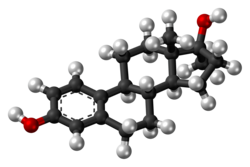Methylestradiol
 | |
 | |
| Clinical data | |
|---|---|
| Trade names | Ginecosid, Ginecoside, Mediol, Renodiol |
| Other names | NSC-52245; 17α-Methylestradiol; 17α-ME; 17α-Methylestra-1,3,5(10)-triene-3,17β-diol |
| Routes of administration | By mouth[1] |
| Drug class | Estrogen |
| Identifiers | |
| |
| CAS Number | |
| PubChem CID | |
| ChemSpider | |
| UNII | |
| KEGG | |
| ChEBI | |
| ChEMBL | |
| ECHA InfoCard | 100.005.572 |
| Chemical and physical data | |
| Formula | C19H26O2 |
| Molar mass | 286.415 g·mol−1 |
| 3D model (JSmol) | |
SMILES
| |
InChI
| |
Methylestradiol, sold under the brand names Ginecosid, Ginecoside, Mediol, and Renodiol, is an estrogen medication which is used in the treatment of menopausal symptoms.[2][3][4] It is formulated in combination with normethandrone, a progestin and androgen/anabolic steroid medication.[3][4] Methylestradiol is taken by mouth.[1]
Side effects of methylestradiol include nausea, breast tension, edema, and breakthrough bleeding among others.[5] It is an estrogen, or an agonist of the estrogen receptors, the biological target of estrogens like estradiol.[6]
Methylestradiol is or has been marketed in Brazil, Venezuela, and Indonesia.[3] In addition to its use as a medication, methylestradiol has been studied for use as a radiopharmaceutical for the estrogen receptor.[7]
Medical uses[]
Methylestradiol is used in combination with the progestin and androgen/anabolic steroid normethandrone (methylestrenolone) in the treatment of menopausal symptoms.[3][4]
Available forms[]
Methylestradiol is marketed in combination with normethandrone in the form of oral tablets containing 0.3 mg methylestradiol and 5 mg normethandrone.[8][9]
Side effects[]
Side effects of methylestradiol include nausea, breast tension, edema, and breakthrough bleeding.[5]
Pharmacology[]
Pharmacodynamics[]
Methylestradiol is an estrogen, or an agonist of the estrogen receptor.[6] It shows somewhat lower affinity for the estrogen receptor than estradiol or ethinylestradiol.[6]
Methylestradiol is an active metabolite of the androgens/anabolic steroids methyltestosterone (17α-methyltestosterone), metandienone (17α-methyl-δ1-testosterone), and normethandrone (17α-methyl-19-nortestosterone), and is responsible for their estrogenic side effects, such as gynecomastia and fluid retention.[10][11][12]
| Compound | PR | AR | ER | GR | MR | SHBG | CBG |
|---|---|---|---|---|---|---|---|
| Estradiol | 2.6 | 7.9 | 100 | 0.6 | 0.13 | 8.7 | <0.1 |
| Ethinylestradiol | 15–25 | 1–3 | 112 | 1–3 | <1 | ? | ? |
| Methylestradiol | 3–10, 15–25 | 1–3 | 67 | 1–3 | <1 | ? | ? |
| Methyltestosterone | 3 | 45, 100–125 | ? | 1–5 | ? | 5 | ? |
| Normethandrone | 100 | 146 | <0.1 | 1.5 | 0.6 | ? | ? |
| Sources: Values are percentages (%). Reference ligands (100%) were progesterone for the PR, testosterone for the AR, E2 for the ER, DEXA for the GR, aldosterone for the MR, DHT for SHBG, and cortisol for CBG. Sources: [13][6][14][15] | |||||||
Pharmacokinetics[]
Due to the presence of its C17α methyl group, methylestradiol cannot be deactivated by oxidation of the C17β hydroxyl group, resulting in improved metabolic stability and potency relative to estradiol.[10] This is analogous to the case of ethinylestradiol and its C17α ethynyl group.[10]
Chemistry[]
Methylestradiol, or 17α-methylestradiol (17α-ME), also known as 17α-methylestra-1,3,5(10)-triene-3,17β-diol, is a synthetic estrane steroid and a derivative of estradiol.[2][3] It is specifically the derivative of estradiol with a methyl group at the C17α positions.[2][3] Closely related steroids include ethinylestradiol (17α-ethynylestradiol) and ethylestradiol (17α-ethylestradiol).[2] The C3 cyclopentyl ether of methylestradiol has been studied and shows greater oral potency than methylestradiol in animals, similarly to quinestrol (ethinylestradiol 3-cyclopentyl ether) and quinestradol (estriol 3-cyclopentyl ether).[16]
History[]
Methylestradiol was first marketed, alone as Follikosid and in combination with methyltestosterone as Klimanosid, in 1955.[17][18][19][20]
Society and culture[]
Generic names[]
Methylestradiol has not been assigned an INN or other formal name designations.[2][3] Its generic name in English and German is methylestradiol, in French is méthylestradiol, and in Spanish is metilestadiol.[3] It is also known as 17α-methylestradiol.[3]
Brand names[]
Methylestradiol is or has been marketed under the brand names Ginecosid, Ginecoside, Mediol, and Renodiol, all in combination with normethandrone.[3][2]
Availability[]
Methylestradiol is or has been marketed in Brazil, Venezuela, and Indonesia.[3]
References[]
- ^ a b HEGEMANN O (May 1959). "[Oral hormonal treatment with methylestrene-olone & methylestradiol as early pregnancy tests]". Medizinische (in German). 4 (21): 1032–3. PMID 13673847.
- ^ a b c d e f J. Elks (14 November 2014). The Dictionary of Drugs: Chemical Data: Chemical Data, Structures and Bibliographies. Springer. pp. 898–. ISBN 978-1-4757-2085-3.
- ^ a b c d e f g h i j k Drugs.com. "Methylestradiol". Retrieved 2 January 2016.
- ^ a b c IARC Working Group on the Evaluation of Carcinogenic Risks to Humans; World Health Organization; International Agency for Research on Cancer (2007). Combined Estrogen-progestogen Contraceptives and Combined Estrogen-progestogen Menopausal Therapy. World Health Organization. pp. 389–. ISBN 978-92-832-1291-1.
- ^ a b Wittlinger, H. (1980). "Clinical Effects of Estrogens". Functional Morphologic Changes in Female Sex Organs Induced by Exogenous Hormones. pp. 67–71. doi:10.1007/978-3-642-67568-3_10. ISBN 978-3-642-67570-6.
- ^ a b c d Ojasoo T, Raynaud JP (November 1978). "Unique steroid congeners for receptor studies". Cancer Res. 38 (11 Pt 2): 4186–98. PMID 359134.
- ^ Feenstra A, Vaalburg W, Nolten GM, Reiffers S, Talma AG, Wiegman T, van der Molen HD, Woldring MG (1983). "Estrogen receptor binding radiopharmaceuticals: II. Tissue distribution of 17 alpha-methylestradiol in normal and tumor-bearing rats". J. Nucl. Med. 24 (6): 522–8. PMID 6406650.
- ^ Unlisted Drugs. Pharmaceutical Section, Special Libraries Association. 1982.
Batynid. C. Each dragee contains: normethandrone, 5 mg.; and methylestradiol, 0.3 mg. E. (Formerly) Gynaekosid. M. Boehringer Biochemia, Florence. A. Estrogenic; Rx of secondary amenorrhea. R. Notiz Med Farm 32;295, Nov-Dec 81.
- ^ Akingba JB, Ayodeji EA (February 1966). "Amenorrhea as a leading symptom of choriocarcinoma". J Obstet Gynaecol Br Commonw. 73 (1): 153–5. doi:10.1111/j.1471-0528.1966.tb05137.x. PMID 5948541.
- ^ a b c Detlef Thieme; Peter Hemmersbach (18 December 2009). Doping in Sports. Springer Science & Business Media. pp. 470–. ISBN 978-3-540-79088-4.
- ^ William Llewellyn (2011). Anabolics. Molecular Nutrition Llc. pp. 533–. ISBN 978-0-9828280-1-4.
- ^ Friedl KE (1990). "Reappraisal of the health risks associated with the use of high doses of oral and injectable androgenic steroids". NIDA Res. Monogr. 102: 142–77. PMID 1964199.
- ^ Raynaud, J.P.; Ojasoo, T.; Bouton, M.M.; Philibert, D. (1979). "Receptor Binding as a Tool in the Development of New Bioactive Steroids". Drug Design. pp. 169–214. doi:10.1016/B978-0-12-060308-4.50010-X. ISBN 9780120603084.
- ^ Ojasoo T, Delettré J, Mornon JP, Turpin-VanDycke C, Raynaud JP (1987). "Towards the mapping of the progesterone and androgen receptors". J. Steroid Biochem. 27 (1–3): 255–69. doi:10.1016/0022-4731(87)90317-7. PMID 3695484.
- ^ Raynaud JP, Bouton MM, Moguilewsky M, Ojasoo T, Philibert D, Beck G, Labrie F, Mornon JP (January 1980). "Steroid hormone receptors and pharmacology". J. Steroid Biochem. 12: 143–57. doi:10.1016/0022-4731(80)90264-2. PMID 7421203.
- ^ Falconi, G., Rossi, G. L., & Ercoli, A. (1970). Quinestrol and other cyclopentyl ethers of estrogenic steroids: different rates of storage in body fat. https://www.popline.org/node/474468
- ^ "Neue Spezialitäten". Klinische Wochenschrift. 33 (31–32): 773–774. 1955. doi:10.1007/BF01473523. ISSN 0023-2173. S2CID 1678069.
- ^ Heinrich Kahr (8 March 2013). Konservative Therapie der Frauenkrankheiten: Anzeigen, Grenzen und Methoden Einschliesslich der Rezeptur. Springer-Verlag. pp. 20–. ISBN 978-3-7091-5694-0.
- ^ Georg Arends; Heinrich Zörnig; Hermann Hager; Georg Frerichs, Walther Kern (14 December 2013). Hagers Handbuch der pharmazeutischen Praxis: Für Apotheker, Arzneimittelhersteller, Drogisten, Ärzte u. Medizinalbeamte. Springer-Verlag. pp. 1156–1157, 1164. ISBN 978-3-662-36329-4.
- ^ Burghard Helwig (1956). Moderne Arzneimittel: eine Spezialitätenkunde nach Indikationsgebieten für Ärzte und Apotheker. Wissenschaftliche Verlagsgesellschaft. p. 240.
- Diols
- Estranes
- Human drug metabolites
- Synthetic estrogens